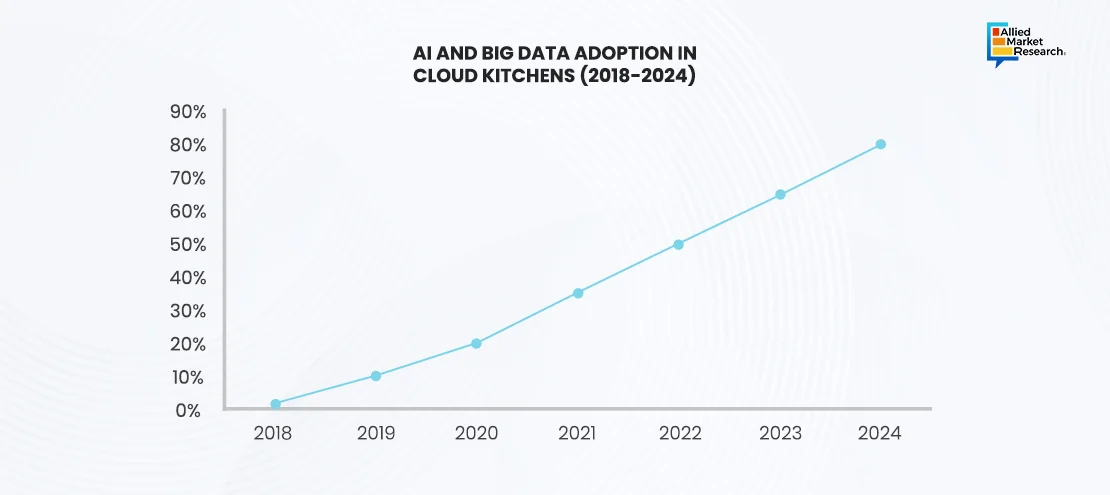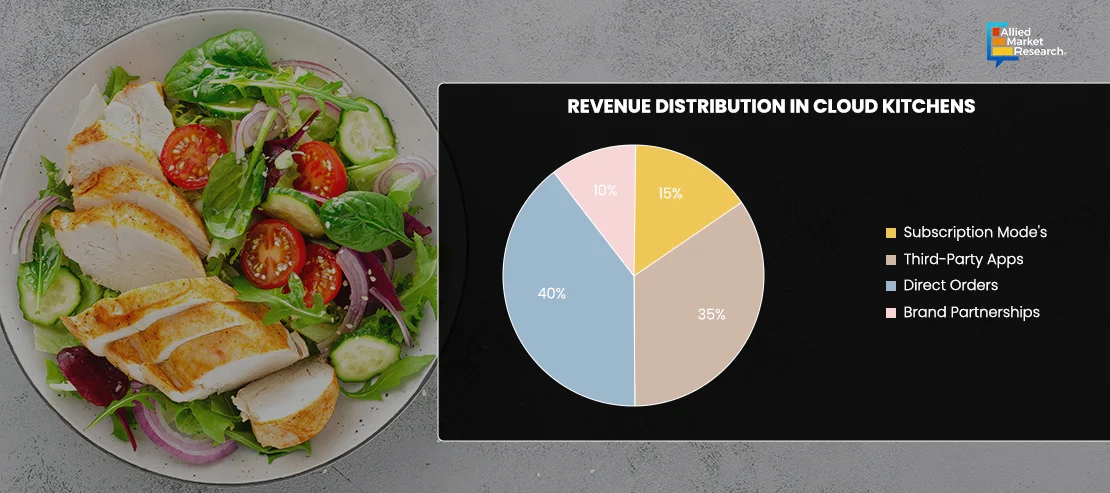Table Of Contents
- Unprecedented Market Growth and Trends
- Rise of Food Delivery Platforms
- Multi-Brand Cloud Kitchens for Diverse Offerings
- AI and Big Data Transforming Operations
- Business Models in the Cloud Kitchen Landscape
- Independent Cloud Kitchens: These are small firms or individual entrepreneurs operating delivery-only kitchens. They only take orders online and don't have a physical store. Startups are drawn to them for their cost-effective operations and the ability to tailor menus with greater flexibility.
- Shared or Commissary Cloud Kitchens: A common kitchen is used by several restaurant companies under this strategy. With the help of services like CloudKitchens and Kitchen United, several food businesses can scale their operations effectively and split infrastructure costs.
- Brand-Owned Cloud Kitchens: The cloud kitchen idea has also been embraced by conventional restaurant chains to increase their delivery presence. Establishing delivery-only sites allows firms to reach customers in high-demand areas and improve operational efficiency without having to pay hefty property costs.
- Aggregator-Managed Cloud Kitchens: Food delivery aggregators such as Zomato and Swiggy run their own cloud kitchens and rent culinary space to other brands. This concept uses vertical integration to help aggregators increase income, guarantee speedy deliveries, and streamline logistics.
- Transformation of Consumer Behavior
- Employment and Workforce Dynamics
- Impact on Real Estate and Urban Planning
- Cities need more well-located kitchen hubs because cloud kitchens create fewer jobs than traditional restaurants. This has changed commercial real estate trends, with empty retail spaces, parking garages, and warehouses being turned into cooking facilities. As delivery traffic increases, people are also discussing dedicated delivery zones, smarter city planning, and eco-friendly last-mile delivery solutions to reduce congestion.
- The Future of Cloud Kitchens
- Automation and Robotics in Food Preparation: The incorporation of AI-powered kitchen assistants, automated cooking stations, and robotic chefs is anticipated to increase productivity and reduce dependence on human labor. While lowering operating expenses, automation will aid in standardizing food preparation.
- Expansion into Emerging Markets: Although cloud kitchens have become quite popular in North America, Europe, and some parts of Asia, there is still a lot of potential for expansion in places like the Middle East, Africa, and Latin America. These markets are projected to become important development areas as food delivery infrastructure advances.
- Proliferation of Virtual Food Brands: Many companies are moving toward food brands that are only available online and through food delivery services. This eliminates the need for a physical restaurant and enables rapid expansion and experimentation with specialty cuisines.
- Emphasis on Sustainability: Eco-friendly methods, such as using biodegradable packaging, cutting down on food waste, and implementing energy-efficient kitchen solutions, are becoming more popular in the sector. Companies that put sustainability first are expected to be at a competitive edge. The next graph shows the increasing adoption of eco-friendly practices, from 10% in 2018 to a projected 85% by 2024. Some of such sustainability initiatives include biodegradable packaging, waste reduction, and energy-efficient operations.
- Personalized Meal Options through AI: Cloud kitchens of the future will use AI to provide highly customized meal alternatives according to historical order history, dietary requirements, and client preferences. Customer satisfaction and brand loyalty will increase as a result.
- Expansion into Smart Cities and Urban Centers: In smart cities with infrastructure customized for digital enterprises, cloud kitchens are predicted to grow in popularity. Operations in urban centers will be completely transformed by the combination of automated delivery systems and IoT-enabled kitchens.
- Rise of Subscription-Based Meal Plans: Cloud kitchen subscription models are becoming more popular, providing consumers with a range of menu options and reasonably priced meal plans. Businesses are benefiting from predictable revenue streams and improved customer retention with this strategy. The displayed graph illustrates the percentage share of revenue sources, highlighting direct orders (40%), third-party apps (35%), subscription models (15%), and brand partnerships (10%).
- Sustainability and Carbon Footprint Reduction: Cloud kitchens are moving toward more environmentally friendly practices, such as waste minimization plans, energy-efficient cooking techniques, and eco-friendly packaging. These initiatives are projected to attract eco-aware customers in addition to supporting global sustainability goals.
- Conclusion

Roshan Deshmukh

Koyel Ghosh
From Local to Global: The Transformational Rise of Cloud Kitchens

The rise of cloud kitchens, sometimes called ghost kitchens or virtual kitchens, has brought about a radical change in the food and beverage sector. Cloud kitchens are delivery-only companies that do not have a traditional dine-in area to accommodate the growing demand for online food delivery. The rapid expansion of food delivery services, changing consumer habits, and innovative technological developments have all contributed to the enormous global appeal of this new concept.
Cloud kitchens have become a key part of the modern food industry, growing even faster due to the COVID-19 pandemic. They are changing how businesses operate by offering flexible, affordable, and tech-driven solutions to meet the rising demand for fast, high-quality, and customizable meals. This article examines the cloud kitchen market along with its main trends, business models, growth factors, obstacles, and potential future developments.
Unprecedented Market Growth and Trends
The landscape of cloud kitchen market has grown rapidly in recent years due to several dynamic variables. The rise in demand for meal delivery due to urbanization, time restrictions, and a growing need for convenience has made cloud kitchens a lucrative substitute for conventional dining establishments.
Rise of Food Delivery Platforms
The expansion of meal delivery services like Uber Eats, DoorDash, Zomato, and Deliveroo has significantly influenced the rise of cloud kitchens. Without a real dining area, these platforms allow food entrepreneurs to reach a large audience. The strategy maximizes market penetration and delivery efficiency while enabling significant cost savings. The following graph shows the influence of food delivery platforms on cloud kitchens. Uber Eats and DoorDash hold the highest share, playing a key role in the growth of the concept.
Multi-Brand Cloud Kitchens for Diverse Offerings
The capacity to run several virtual brands under one roof is one of the main benefits of cloud kitchens. Pioneers like Rebel Foods, CloudKitchens, and Kitopi have successfully implemented this strategy, offering diverse cuisines ranging from Asian specialties to healthy vegan meals. This strategy accommodates a range of customer preferences while generating more revenue.

AI and Big Data Transforming Operations
Cloud kitchen operations are being revolutionized by big data analytics and artificial intelligence . Businesses can maximize output, cut waste, and simplify logistics by examining customer preferences, demand projections, and peak order periods. Predictive analytics comes with the potential to improve supply chain effectiveness, which lowers costs and improves inventory control. The graph below highlights the growing adoption of AI and Big Data in cloud kitchens. AI adoption increased from 5% in 2018 to an expected 80% by 2024. Today’s advanced technology has enhanced order processing, inventory management, and delivery efficiency to a considerable extent.
Business Models in the Cloud Kitchen Landscape
The cloud kitchen industry operates through various models, each designed to maximize efficiency and profitability.

Independent Cloud Kitchens: These are small firms or individual entrepreneurs operating delivery-only kitchens. They only take orders online and don't have a physical store. Startups are drawn to them for their cost-effective operations and the ability to tailor menus with greater flexibility.
Shared or Commissary Cloud Kitchens: A common kitchen is used by several restaurant companies under this strategy. With the help of services like CloudKitchens and Kitchen United, several food businesses can scale their operations effectively and split infrastructure costs.
Brand-Owned Cloud Kitchens: The cloud kitchen idea has also been embraced by conventional restaurant chains to increase their delivery presence. Establishing delivery-only sites allows firms to reach customers in high-demand areas and improve operational efficiency without having to pay hefty property costs.
Aggregator-Managed Cloud Kitchens: Food delivery aggregators such as Zomato and Swiggy run their own cloud kitchens and rent culinary space to other brands. This concept uses vertical integration to help aggregators increase income, guarantee speedy deliveries, and streamline logistics.
The Real-World Implications of the Cloud Kitchen Market
The global market for cloud kitchens is significantly transforming the food and beverage sector. In contrast with traditional dining establishments, cloud kitchens mostly serve consumers via online delivery platforms and do not have dine-in areas. Undoubtedly, the approach offers cost-efficiency and scalability benefits, but its influence extends beyond corporate profitability to include employment trends, consumer behavior, and urban infrastructure.
Transformation of Consumer Behavior
Cloud kitchens have had a big impact on how consumers get food, emphasizing speed, convenience, and personalization. There is a greater need for specialty cuisines and healthier options catered to personal preferences as a result of the growing reliance on meal delivery apps like Uber Eats, Zomato, and DoorDash. Furthermore, food manufacturers are being forced to constantly innovate as consumers now demand hyper-personalization, including AI-driven recommendations and subscription-based meal plans.
Employment and Workforce Dynamics
Although cloud kitchens generate employment, it's unclear how they will affect regular restaurant employment. Cloud kitchens have caused many restaurants to reduce staff or close, moving front-of-house positions to backend functions like food preparation and delivery logistics. Moreover, gig economy workers including delivery staff have grown to be an important component of the ecosystem, addressing questions regarding fair compensation, job security, and working conditions. Companies are increasingly investigating automation to further reduce human involvement in order fulfillment and meal preparation.
Impact on Real Estate and Urban Planning
Cities need more well-located kitchen hubs because cloud kitchens create fewer jobs than traditional restaurants. This has changed commercial real estate trends, with empty retail spaces, parking garages, and warehouses being turned into cooking facilities. As delivery traffic increases, people are also discussing dedicated delivery zones, smarter city planning, and eco-friendly last-mile delivery solutions to reduce congestion.
The Future of Cloud Kitchens
The cloud kitchen industry is expected to witness further expansion, driven by ongoing technological advancements and evolving consumer demands.
Automation and Robotics in Food Preparation: The incorporation of AI-powered kitchen assistants, automated cooking stations, and robotic chefs is anticipated to increase productivity and reduce dependence on human labor. While lowering operating expenses, automation will aid in standardizing food preparation.
Expansion into Emerging Markets: Although cloud kitchens have become quite popular in North America, Europe, and some parts of Asia, there is still a lot of potential for expansion in places like the Middle East, Africa, and Latin America. These markets are projected to become important development areas as food delivery infrastructure advances.
Proliferation of Virtual Food Brands: Many companies are moving toward food brands that are only available online and through food delivery services. This eliminates the need for a physical restaurant and enables rapid expansion and experimentation with specialty cuisines.
Emphasis on Sustainability: Eco-friendly methods, such as using biodegradable packaging, cutting down on food waste, and implementing energy-efficient kitchen solutions, are becoming more popular in the sector. Companies that put sustainability first are expected to be at a competitive edge. The next graph shows the increasing adoption of eco-friendly practices, from 10% in 2018 to a projected 85% by 2024. Some of such sustainability initiatives include biodegradable packaging, waste reduction, and energy-efficient operations.
Personalized Meal Options through AI: Cloud kitchens of the future will use AI to provide highly customized meal alternatives according to historical order history, dietary requirements, and client preferences. Customer satisfaction and brand loyalty will increase as a result.
Expansion into Smart Cities and Urban Centers: In smart cities with infrastructure customized for digital enterprises, cloud kitchens are predicted to grow in popularity. Operations in urban centers will be completely transformed by the combination of automated delivery systems and IoT-enabled kitchens.
Rise of Subscription-Based Meal Plans: Cloud kitchen subscription models are becoming more popular, providing consumers with a range of menu options and reasonably priced meal plans. Businesses are benefiting from predictable revenue streams and improved customer retention with this strategy. The displayed graph illustrates the percentage share of revenue sources, highlighting direct orders (40%), third-party apps (35%), subscription models (15%), and brand partnerships (10%).
Sustainability and Carbon Footprint Reduction: Cloud kitchens are moving toward more environmentally friendly practices, such as waste minimization plans, energy-efficient cooking techniques, and eco-friendly packaging. These initiatives are projected to attract eco-aware customers in addition to supporting global sustainability goals.
Conclusion
Cloud kitchens are transforming the food service industry with a smart, scalable, and cost-effective alternative to traditional restaurants. While challenges like supply chain issues and competition are still there, the market is still growing due to rising customer demand and technological advancements.

Companies that are investing in AI-driven logistics, digital tools, and sustainability initiatives are expected to gain a strong advantage. The concept of food delivery is expanding at a significant pace and cloud kitchens are anticipated to reshape dining by blending culinary expertise with convenience.
AtAllied Market Research,we provide in-depth insights, market trends, and data-driven strategies to help vendors maximize their potential in this evolving space. Our expert analysis equips businesses with the knowledge to optimize operations, enhance customer reach, and stay ahead of competition. Whether it's understanding consumer behavior, identifying growth opportunities, or utilizing the latest technology, AMR empowers companies to explorethe cloud kitchen revolution with confidence.
To take advantage of the evolving cloud kitchen market trends, contact our experts today!


